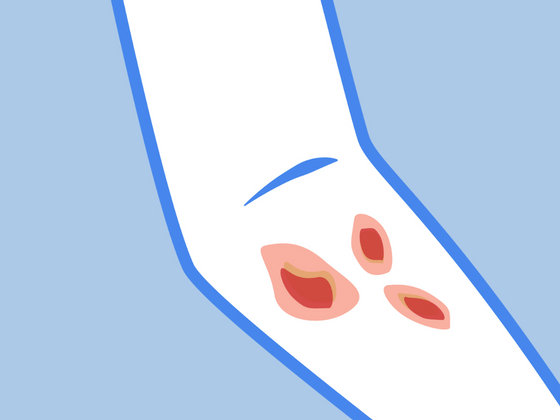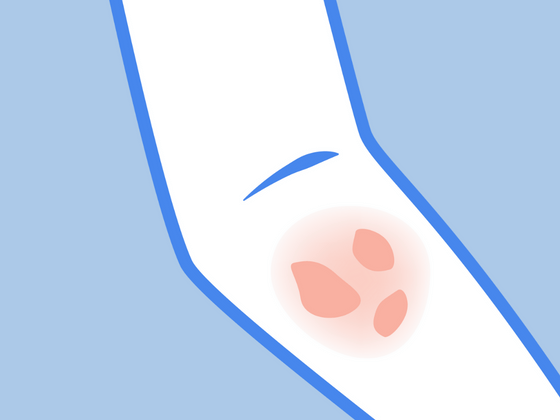The days leading up to your period each month can be a rollercoaster. Maybe you experience mood swings or weight gain, bloating, or acne outbreaks - but do you also notice your skin breaking out in a mysterious rash that clears up as soon as menstruation starts?
If this sounds familiar, you might be experiencing a rare condition called autoimmune progesterone dermatitis, an allergic reaction that affects many women and people who menstruate throughout their childbearing years.
Throughout this post, we're going to explore everything you need to know about:
-
The causes of autoimmune progesterone dermatitis
-
The main symptoms of progesterone dermatitis
-
How to treat menstruation-related skin rashes naturally and effectively
Keep reading to understand more about the underlying links between your skin condition and menstrual cycle, learning how to soothe your premenstrual skin rashes.
What is Autoimmune Progesterone Dermatitis?
Progesterone dermatitis is a rare skin condition characterized by a cyclic skin rash during the luteal phase of the menstrual cycle, approximately 3-10 days before you get your period.
Typically, these skin rashes will subside 1-2 days after you begin menstrual bleeding once endogenous progesterone levels have dropped again.
Who Is Most At Risk?
Progesterone dermatitis is most commonly experienced by people during adulthood who are on birth control pills; however, for some, it may occur throughout pregnancy and post-menopause, too.
Progesterone Dermatitis: The Main Causes
Progesterone dermatitis is caused by a hypersensitivity reaction towards the sex hormone progesterone, which is responsible for creating a healthy uterine lining to support reproduction.
Progesterone sensitivity occurs when the body's immune system interprets endogenous hormones (such as progesterone) as an allergen, triggering a full-blown allergic reaction.
Unfortunately, little is known about why some people's bodies trigger allergic reactions in this way. However, progesterone dermatitis most often occurs among people exposed to exogenous progesterone sources, such as oral contraceptive pills.
Symptoms To Look Out For
The symptoms of autoimmune progesterone dermatitis will differ for every individual. However, there are some common skin problems that you'll want to look out for:
Contact Dermatitis
You might experience contact dermatitis, a skin rash characterized by dry, flaky, and intensely itchy patches of skin, triggered as part of the body's allergic reaction response.
Hives
Many progesterone dermatitis patients develop hives - a form of skin rash that causes red raised bumps or welts on the skin that may appear brown or purplish on darker skin tones.
In these instances, hives are caused when specific cells, called mast cells, release histamine into the bloodstream as part of an allergic reaction towards progesterone.
Autoimmune progesterone urticaria (or menstrual cycle-dependent urticaria) is a form of chronic hives that tends to be longer-lasting, creating welts and open sores.
Erythema Multiforme
Another common symptom is erythema multiforme - a skin disorder that typically develops on the fingers and toes and is characterized by symmetrical, red, raised skin areas.
As erythema multiforme spreads, rash patches may begin to look like targets with discolored rings.
How Do You Treat Autoimmune Progesterone Dermatitis?
The treatment options available for tackling this rare skin disorder are two-fold.
Firstly, you may wish to engage in hormone therapy or take medications to inhibit ovulation to manage your body's progesterone levels.
Secondly, you may focus on managing the rash symptoms of progesterone hypersensitivity to help restore your skin to health.
Treating Progesterone Dermatitis Rashes
Allergic reactions to progesterone trigger many skin conditions, each requiring slightly different treatment methods.
That said, there will be a few common issues that impact most people with progesterone hypersensitivity throughout their monthly cycle, such as dry skin, itchiness, inflammation, skin flaking, cracking, or open sores. For these symptoms, an eczema cream may help provide relief.
If these symptoms sound all too familiar, we've got some ideas to get you started on recovery!
Use An Effective Moisturizer
This Organic Calendula Salve contains vitamins, antioxidants, essential fatty acids, plant compounds, and natural enzymes to help nourish your sensitive skin.
Commonly known as the "mother of the skin" in herbalist circles, calendula oil is often used as a complementary or alternative treatment to manage skin conditions such as eczema.
For an intensive treatment, generously apply the salve to all affected areas across your body after you get out of the shower or bath to help your skin lock in even more hydration.
Gentle Soap Products
The Emily Liquid Soap Soother is a natural body wash made using the principles of Chinese medicine, designed especially for people with eczema and susceptible skin. With no added color or fragrance, this eczema soap is free from any added allergens or irritants</strong>, helping keep your skin clean without stripping the skin barrier of the essential natural oils you need to heal.
Wear Breathable Clothing
If you've broken out in a wide-scale rash, reach for soft, comfortable clothing made from 100% hypoallergenic fabrics to avoid worsening your symptoms.
The Remedywear™ (TENCEL + Zinc) Long Sleeve Shirt and Pants are excellent full-body coverage options.
These incredibly lightweight, soothing clothes are made with eco-friendly, breathable TENCEL and embedded with anti-inflammatory zinc. As a hypoallergenic, natural mineral, zinc is known to help combat the urge to scratch while inhibiting bacterial growth in fabrics to support healing.
Treat your Autoimmune Progesterone Dermatitis Rash Today
Follow these steps to help you understand why your skin keeps breaking out in these monthly rashes and how best to soothe and tackle your symptoms today.








